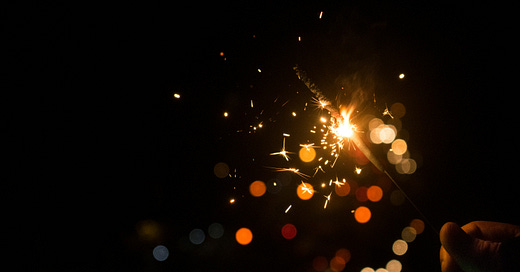I was scrolling idly through Instagram one day when I heard this surprising and totally against-the-grain advice emit from this bearded, orange-sunglasses-clad man on the screen:
"The audience comes last."
My ears perked. This was Rick Rubin, the legendary music producer, who had just released a book called The Creative Act. To promote his book, he did an interview on 60 Minutes with Anderson Cooper.
Now, in the entrepreneurial world, and in many corners of the writing and creative worlds, that's like spitting in the face of accepted wisdom. You don't do that!
Audience supposedly comes first—you define exactly who it is you're talking to. Otherwise, how do you know who to sell it to?
Rick said, "The audience only knows what's come before."
"Isn't the whole music business built around trying to figure out what somebody likes?" asked a perplexed Anderson Cooper.
"Maybe for someone else it is, but it's not for me," Rick answered.
The chutzpah! thought the organized, strategic part of me that likes to plan, who has written and taught about the need to be clear on your audience for years.
Yasssss, sighed the artist in me, who felt relief.
I see this urge growing within my fellow creative friends and clients, too. A while back, a client of mine came to the decision that she was creating her book, a mix of her art and stories, for her and that she didn't need to bother with "pleasing the audience." Like Rubin, her audience couldn't possibly know what she had to offer, and if she tried to tailor it to what they might like, she would only curb herself and her readers wouldn’t get the full story.
Not to mention the fact that this woman is a successful working artist—she tailors her art to people's taste as a matter of business. This book is going to be her space to say and express exactly what she wants to, exactly HOW she wants to, without needing to cater to the tastes and preferences of other people.
To be clear, there is a lot of value in knowing your audience if you have clear plans to sell whatever it is you’re creating commercially or en masse. That’s still true.
But there is equally as much value, if not more, in creating the thing that you want to see exist out in the world. Choosing your own creative taste over that of an audience doesn’t mean you can’t sell it later. It just means the way you market it and sell it will have to adapt.
If you’re going to go this route, it’s a good idea to choose one path and stick with it, meaning that you can’t go back and forth between being driven by your audience and being driven by your creative spark. While there is a time for feedback, the primary feedback loop has to be a conversation with yourself (or with your muse, god, spirit—however you like to arrange your cosmology). Do you like it? Does it feel like the closest iteration of the thing that you envisioned in the first place, imperfections and all? As architect Christopher Alexander said when making decisions about his art or aesthetic, “Does it remind you of your ‘Eternal Self?’”
Cultivate the sense of knowing what it feels like to be on a path. In a recent creative endeavor, I felt inspired and moved on a daily basis. I was creating something that I loved. There were no sticking points, and the ideas came at a steady pace, moving me forward… until I made a decision that brought me back suspiciously close to the place from which I’d started.
Within a day, I knew the energy had died—I felt it in my body and saw it in my behavior. Instead of feeling inspired, I felt an overwhelming urge to numb out by binge-watching Outlanders on Starz. This is not normal for me, so as I sat watching my show at 10 AM on a Tuesday, stuffing my face with chocolate, I kept my mind open for the inquiry: what got me stuck? You could say this is a low point, and yet it would only have been a low point if I stayed there. The block showed me that I’d strayed from my values in this project, and the moment I’d strayed, the energy and enthusiasm died.
The real win here isn’t necessarily getting through the block (which I did), but it’s being able to recognize that there was a block in the first place, right away, and to understand why it arose. Getting back to my values in this project helped me get back on my way.
Finally, accept the ambiguity and uncertainty of creating from a place of desire. We reach too quickly for certainty. We want to know the outcome, the ROI. We need to have things locked down and clear enough to explain to another person. We don’t like admitting “I don’t know,” especially when that other person probably thinks we should know (or when we think we should know). But part of any creative process is a fair bit of ambiguity and uncertainty, even doubt. Get comfortable with the messy middle—which can be a long affair—where resolution doesn’t come fast, and you have more questions than answers. Another way of saying this: respect the process… which takes time.





Good stuff. The creative's path reveals their Great Work, which for creatives includes their art. That Work is done for their soul's purpose here on earth. The audience serves as mirror.
Great post! And yeah, it's such a balance between being an artist and staying true to yourself and, well, paying the bills. And if you throw trauma or family drama into the mix, well, even more muck to process and overcome.